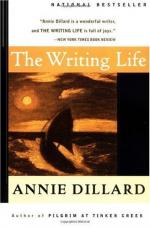|
This section contains 672 words (approx. 2 pages at 400 words per page) |

|
The Writing Life Summary & Study Guide Description
The Writing Life Summary & Study Guide includes comprehensive information and analysis to help you understand the book. This study guide contains the following sections:
This detailed literature summary also contains Topics for Discussion and a Free Quiz on The Writing Life by Annie Dillard.
This short book by renowned novelist Annie Dillard explores her perspective on the practice of being a writer. Commentary on the craft of writing is juxtaposed with narration of the author's personal experiences, all of which are grounded in the extended metaphor that creating a literary work is, essentially, following "a line of words." The themes of the book are also grounded in that metaphor, specifically in their investigation of the contrasting natures of that line and the simultaneous effortlessness and hard work that go into following it truthfully.
In the first chapter, the author begins with a statement of her central thematic perspective - that a piece of writing is a "line of words" that a writer follows to its natural, perhaps unexpected, end. She then, in considerable and sometimes harsh detail, describes a key component of that process: the cutting away of words, scenes, chapters, characters, incidents, etc. that get in the way of that line being both followed and interpreted clearly by a reader. At the end of the first chapter she returns to the image of the line of words, suggesting that the line is somehow, in some way, connected to the writer's beating heart, and as such will, if the line is followed truthfully, connect to the heart of the reader.
The middle section of the book explores the author's personal experience of, and perspective on, her own writing life. She offers her opinion that a writer needs a certain degree of isolation from the outside world in order to focus on the inner world of the characters s/he is creating, the lives they are living, and the reasons they are living the way they do. She also examines the nature of the ideas and/or originating images at the core of a work of writing, and how those initial images and ideas are often completely transformed and occasionally even discarded as the true nature of the work, the destination of the "line of words," makes itself apparent. Throughout this section, the author's emphasis is on the intense work it takes to craft a piece of writing, exploring the agonies of distraction and avoidance she and other writers put themselves through, the views of non-writers on the writing process, and how the struggle to create distills into the torturous creation of simple, but perfect, sentences. Throughout this middle section, the author develops a variation on the central metaphor. This is the idea that the "line of words" can, and often does, take on a life, a presence, an energy of its own that the writer must simultaneously allow to take shape and struggle to give shape.
The final two chapters are taken up with lengthy narratives of a pair of encounters experienced by the author, encounters that appear to be clear metaphors for the different aspects of the writer's struggle as defined above. Chapter 6 tells the story of a man who was so determined to bring a beautiful piece of driftwood back to his home that he rowed against the tide until the tide changed and eventually brought him back to where he wanted to be. The metaphor here is that the writer, and perhaps even other artists, struggles against the creative tide of the "line of words" until the intentions of the line and the artist merge. In other words, the author is speaking of the struggle to surrender.
In Chapter 7, the author narrates the story of an artist whom she believes (and to continue the image) has indeed surrendered to the beauty of his art. The man is a stunt pilot who, as the author describes him and his flying, follows a "line of beauty" (much as the writer follows a "line of words") effortlessly, instinctively, and always with the pleasure and/or reaction of his audience in mind. In other words, the author here is speaking of the art that can result once the struggle ends and surrender to the momentum, to the life of the work is embraced.
Read more from the Study Guide
|
This section contains 672 words (approx. 2 pages at 400 words per page) |

|



